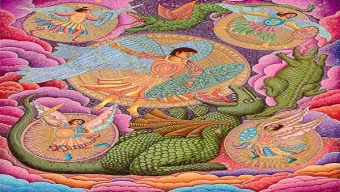Michaelmas is celebrated in the Waldorf schools, which celebrate it as the “festival of strong will” during the autumnal equinox.
Often times the Waldorf schools will hold a play in honor of St. Michael and his slaying of the dragon. In this play, Saint Michael is often seen being knocked to the ground and momentarily stunned by a dragon, usually played by several students in a long dragon costume. Of course, St. Michael bounces right back up and conquers the dragon. The key element of the Michaelmas festival is that it celebrates inner strength and courage. The festivities,include the enjoyment of a small feast after the play, which includes baked loaves of bread shaped like dragons. Dragons are a central theme of Michaelmas because St. Michael, who represents courage, is traditionally pictured subduing a dragon. The primary idea behind the festival of Michaelmas is to get children to face their own challenges – in other words, their internal and external dragons.
Because Michaelmas falls near the equinox, it is commonly associated with the beginning of autumn. So Waldorf schools also use Michaelmas to teach students the importance of using courage to prepare for the colder, darker, winter months.
It’s symbolic of darkness, so it’s important for children to have warmth inside with them. In addition to honoring St. Michael and marking the beginning of fall, Michaelmas represents harvest time – a time when people make preparations for the winter.
This page gives some history, several verses, a Michaelmas circle, some meditations and activities for Michaelmas as celebrated in Waldorf Schools.
The human being is woven with his whole existence and activity into the spiritual world. ~ Rudolf Steiner
{+++}
Michaelmas, the feast of Saint Michael the Archangel (also the Feast of Saints Michael, Gabriel, and Raphael, the Feast of the Archangels, or the Feast of Saint Michael and All Angels) is a day in the Western Christian calendar which occurs on 29 September. Because it falls near the equinox, it is associated in the northern hemisphere with the beginning of autumn and the shortening of days. Michael is the greatest of all the archangels and is honored for defeating Lucifer in the war in heaven.
The Archangel Michael is one of the principal angelic warriors, seen as a protector against the dark of night, and the administrator of cosmic intelligence. Michaelmas has also delineated time and seasons for secular purposes as well, particularly in the United Kingdom and Ireland as one of the quarter days. The Eastern Orthodox Churches do not observe Michaelmas. The Greek Orthodox honor the archangels on 8 November instead.
Golden light is turning grey,
Mists begin to rule the day.
Bare the trees, their branches lift;
Clouds of dead leaves earthward drift.
Through the field the farmer goes,
Seeds of ripened corn he sows;
Trusts the earth will hold it warm,
Shelter it from cold and harm.
For he knows, that warmth and light
Live there, hidden from our sight;
And beneath a sheltering wing,
Deep below, new life will spring!
Deep below, deep below, new life will spring!
Michaelmas Circle:
The autumn wind blows open the gate,
O Michael, you, you we await.
We follow you, show us the way.
With joy we greet the autumn day,
Good morning, good morning
And I wonder who is this Michael? And I hear the wind sing:
Michael, God’s great knight,
Strong and pure and shining bright.
I’ll be a knight of Michael, too,
And polish my crown to a golden hue.
Ask the gnomes the iron to mine,
Iron from the stars, from the earth, so fine,
To bring to the blacksmith, who with his might
Will make me a sword, so strong, so bright.
And we follow the falling stars to the mountain cave where the gnomes are working.
And the gnomes say:
With fire and stone, we work with a will
With our strength and our skill.
The iron we soften and then we bend
Into hammers, swords, and nails to mend.
Dear gnomes, may I have some iron?
Are you noble? Oh, yes.
Are you good? Oh, yes.
And do you hear the singing of the stars? Oh yes.
Then you may have some iron.
(Song) Thank you little gnomes, in your crystal homes.
Oh bring me a galloping horse for to ride,
A crown on my head, the iron by my side.
Off to the blacksmith we must go.
Galloping, galloping, off we go.
Dear blacksmith, will you make me a sword?
Of course! for:
I am a blacksmith, strong and true, Best of work I always do.
All day long my hammers go, slinging, clanging, clanging, so,
A rickety, tickity, tickity, tick,
A rickety, tickity, tickity, tick.
Thank you, kind blacksmith, for your might.
I’ll polish my sword, so fine, so bright.
I will use it for the right,
Not for some silly quarrel or fight,
But to drive away evil, I will try
And protect those who are weaker than I.
(After a week or two of the preceding, the following is added.)
Oh bring me a galloping horse for to ride,
A crown on my head, my sword by my side,
For it’s off the to castle we will go.
Galloping, galloping, here we go.
The knights came together and proclaimed
No fear here! Michael, be my guide and stand by my side.
And they knew that Michael was always ready to help.
Michael, God’s great knight,
Strong and pure and shining bright.
Songs and verses compiled from the Wynstones Autumn book, the oral tradition, and other sources
Gifts For You!
Taming The Dragon: Michaelmas in the Kindergarten
How can we find the right imagination to bring to young children around the festival of Michaelmas? For many years I have lived with the questions: I work in a mature school which has rich traditions around this festival. A large dragon is constructed by the sixth grade class, so large that they all fit inside. At the festival, the third grade class is dancing a harvest dance when the dragon arrives. But behold, Michael appears (a carefully chosen twelfth grader) and, supported by verses recited by classes 2-12, subdues the dragon in a gesture with his sword.
Our kindergarten often included a story of George and the Dragon and the making of wooden swords, but I was a strong pacifist and struggled with the idea of arming the children, even if it was to overcome the dragon. As a mother of three sons, I had for many years focused on non-violence and peace, but I found I was meeting a very strong counter stream within my boys that needed understanding. For a while I became a militant pacifist but then saw that this counter stream was a dynamic with which I needed to work.
When I first became a kindergarten teacher, I searched for different, gentler images and activities to bring to my class for Michaelmas. I found many wonderful stories in the Wynstones Autumn book and through conversations with wise teachers. Working with wood, rasping, sawing, drilling, and polishing, was a wonderful activity in the kindergarten, and I found the older boys were especially satisfied, but I was not at ease with the swords. So one year we made golden capes instead, dyed from the gold gathered in the drying of our marigolds. I told a gentle story about Michael leading the star children across the stormy sea. This was beautifully suited to the younger children; however, upon reflection that year, I saw a certain restlessness in the older boys. The need for the archetypes of the hero who conquered the evil and of the knight who was brave and true had not been met. The emerging will of these young boys was seeking resistance, needing to tame the dragon. We see it on the playground as these young boys delight in pushing against the density of the earth in the sandbox or digging a hole. They needed their will engaged in transforming substance. So I began to look at the sword in a new way. I created a circle that would give images in which to understand and transform the role of the sword.
I still choose the Michaelmas story with care, rewriting the story of George and the Dragon or finding a simpler story if my class is young. And we have continued to make the silk capes. I have come to see that in our time the children need the cape of light to give them courage and strength. From the gathering and drying of the petals of the marigold early in the school year, to the days just before Michaelmas, this has proved to be a wonderful activity. We stir the petals in a big pot and it simmers all day. The next day we drain the mixture through cheesecloth, and each child gets to dye a cape. These are 35×35 inch scarves available from Rupert, Gibbon and Spider (800-442-0455) for a very reasonable cost. I have already sewn down one edge for a casing, and we all twizzle a tie from two strands of yarn. The children love this project. One girl commented, “We put the white silk in the dark water and it comes out gold.” They look so lovely as they dry on the line outside the class. After being finished by ironing and putting the tie through, each child receives one on Michaelmas with the words, “I give to you a cape of light, to give you courage, strength, and might” (a line from the Michaelmas play).
In addition, I have returned to the making of wooden swords for those who wish to. The children spend several weeks sanding, first the long piece and then the crosspiece. We begin with homemade sandpaper we make with heavy paper, white glue, and sifted sand from the sandbox, and gradually get to the fine, store-bought sandpaper. Finally we cut pegs from a dowel and drill the hole to join the twonotched pieces together. We hammer in and glue the peg and then paint the swords a beautiful gold with our watercolors. They dry overnight and are then sanded with the finest sandpaper and oiled. Then they are then placed carefully on the nature table until Michaelmas.
At the end of our Michaelmas celebration day, each child receives her cape of light. The children who have made a sword are given it with the words, “You have polished your sword so strong, so bright. Use it only for the right” (from the circle). I also give the parents a copy of part of the verse and ask their help in keeping this mood at home for the sword. This imagination lives within the class for the whole year, for when I went to put away the Michael puppet the children asked where he was. They have been delighted and satisfied that he now lives near the morning candle. The older boys carry Michael into free play, and one feels a strengthening of their resolve to be courageous, to subdue the dragon, and to serve
the right.
By Barbara Klocek, Used with Permission
Useful Links & Resources:
- Ancient Michaelmas Traditions (.pdf file)
- A Second Grade Michaelmas Play (.pdf file)
- Michaelmas Star Ball (.pdf file)
Inner Thinking
Following the celebration of our Michaelmas Festival, one might ask — what is all this about going into battle? Many families are concerned in this year of crisis about a possible war looming on the horizon. Is this what St. Michael’s battle is all about?
Rudolf Steiner said that the outer conflict of Michael and the Dragon was transferred to the inner human being, because only in human nature can the Dragon now find its sphere of action. Thus, we are called to face our own darkness with courage and light. It is even time to question: when we find the “enemy” in the outer world, are we just avoiding facing him in ourselves? And also: how can one be a “peaceful warrior,” taking a stand with courage for a higher truth?….
Meditation is from Rudolf Steiner’s Last Lecture:
Springing from Powers of the Sun,
Radiant Spirit-powers, blessing all Worlds!
For Michael’s garment of rays
Ye are predestined by Thought Divine.
He, the Christ-messenger, revealeth in you —
Bearing mankind aloft — the sacred Will of Worlds.
Ye, the radiant Beings of Æther-Worlds,
Bear the Christ-Word to Man.
Thus shall the Herald of Christ appear
To the thirstily waiting souls,
To whom your Word of Light shines forth
In cosmic age of Spirit-Man.
Ye, the disciples of Spirit-Knowledge,
Take Michael’s Wisdom-beckoning,
Take the Word of Love of the Will of Worlds
Into your souls’ aspiring, a c t i v e l y !




















